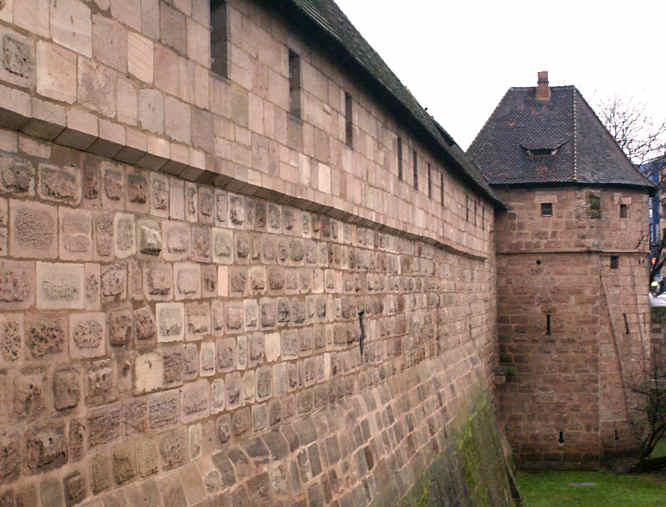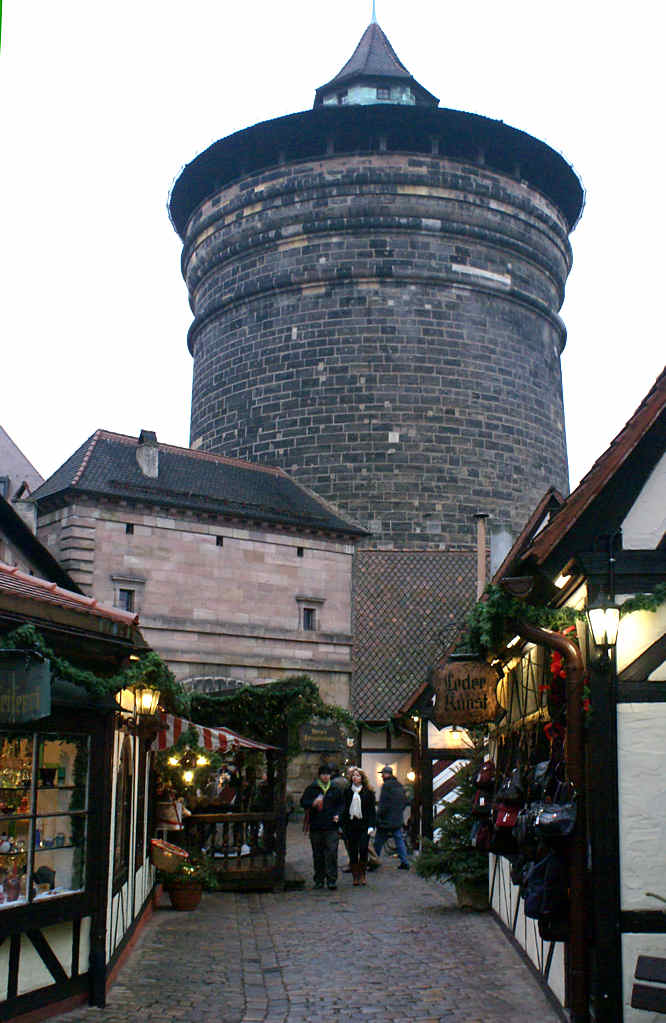Nuremberg Christmas Craftsmen's Courtyard
As you get out of the Nuremberg Railway station look up to see the massive Konigstor city wall castle tower called the Dicker Turm or fat tower.

Walk across the road and under the gate to enter the enchanting historic old city of Nűrnberg. Just inside the gate you will find the first specialist Christmas market called the Craftsmen's Courtyard (Handwerkerhof). It is at the foot of the tower. It is free to enter. As you go through the courtyard gate you will discover small half timbered enchanting black and white buildings that house craftsmen's work studios and shops.

National Museum of Germany (Germanisches Nationalmuseum)
If it is raining or cold visit the National Museum of Germany (Germanisches Nationalmuseum). It was founded in 1852 and is now the largest museums of art and crafts in all German-speaking countries. With over 1.5 million objects available, although only 200,000 items are in permanent display. There are something from everyone, from garden sculptures to toys, from prints and drawings to coins and medals. The museum is spread out over several interconnected buildings, some new, some old and some very old. It is at Kartausergasse 1
DB-Museum German Railway Museum
The Transportation Museum in Nurnberg is now officially called the DB-Museum because it belongs to the German Railway System (DB = Deutsche Bahn). If you love stream trains or arin Nurembergwith children then this is the museum for you. It documents the history of the railroads in Germany from the beginning to the present day. There is even a super fast ICE Train (inter City Express) for you to look at. Closed Mondays It is at Lessingstr. 6. Go around to the back of the opera house and walk down to the end of the block. The museum is right there on the corner. www.dbmuseum.de
Kaiserburg (the Emperor's Castle)
On a slight hill at the northern edge of Nurnberg's Old Town you can see the Emperor's Castle, which has been there since at least the year 1050 and was the emperor's residence when he came to visit. In the old days the Emperor didn't have a capital city. He traveled around from one place to the next. A visit from the Emperor was a mixed blessing, because the town and its people had to pay all the costs for the upkeep of him and his court. They were honored, presumably, to have him come and visit, but relieved when he moved on. You can walk around the castle grounds for free, or pay for a tour which also gets you into the museum and one of the towers. The view from the castle is very impressive.
The Third Reich in Nuremberg
Most people outside Germany associate Nuremberg with the war crime trials after World War Two. You can still see the palace of justice court room buildings at barenschanzstrasse 72. It is north west of the old town. In 1946 it was the only undamaged building in the Nuremberg area that was large enough to hold the trial. On weekends it is possible to have a look at Courtroom 600, where the trial was mainly held. Tours are at 1.00, 2.00, 3.00 and 4.00 p.m on Saturdays and Sundays only.
They are advertised as being in German, but when I was there only five or six of the thirty people present were German speakers, so he did it in German and English. From central Nuremberg take the u-bahn train U-1 and get off at the Barenschanze station. There is another building to see for those interested in recent historic events. The Kongresshalle (Bayern strasse 110) to the South West of the old town looks a little bit like the famous coliseum in Rome! Nuremberg used to be Hitler's show-off city; once a year the town hosted the "Reichsparteitag" when (chosen) people from all over the country wound come and march and sing.
The unfinished Congress Hall and the other huge structures on the former Nazi Party Rally Grounds were made of large pieces of stone that were hewn by prisoners doing forced labor at concentration camps like Flossenburg, Mauthausen, Gross-Rosen, and Natzweiler-Struthof, which were set up near stone quarries for this purpose. Today it is used for storage and as a car park, but nobody really knows what to do with it. It sits there, falling to pieces.
Part of it has been turned into a museum: 'Third Reich in Nuremberg'. It is across the lake from the Zeppelinfeld. Take the bus 36, 55, 65 or by train from the central train station The altes rathaus, (old city hall) next to the Hauptmarket in central Nuremberg was once the site of speeches by Nazi party big wigs during the Nuremberg party rallies. Today you can take a tour of it's 14th century dungeons. Closed Monday.
The Ehrenhalle was built in 1929 as a military monument during the 1930's Nazi party rallies. It was part of the luitpold arena were Hitler addressed S.A. and S.S. storm troopers. The Ehrenhalle was surrounded by stone bleachers that could accommodate 150,000. today most of these bleachers are covered with earth and the area is now used as a public park. It is of Bayern strasse. The Zeppelintribune grand stand was built in 1933 for the first Nazi party national rallies. these rallies where held in September in 1933 through 1938. the rallies were discontinued on the out break of WWII.
During the years of the third Reich the Zeppelintribune underwent several changes. these additions and up grades were supervised by Albert Speer. on the top of the large building in the center of the grand stand was a huge swastika. it was blown up by American troops in 1945. also, there was a row of columns on the top of the grand stand. They were removed in 1967. The Nuremberg Nazi party complex is an interesting place to visit for the student of 20th century history. to see before and after pictures of the Zeppelintribune visit www.thirdreichruins.com
Travel books

